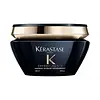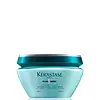What's inside
What's inside
 Key Ingredients
Key Ingredients

No key ingredients
 Benefits
Benefits

 Concerns
Concerns

 Ingredients Side-by-side
Ingredients Side-by-side

Water
Skin ConditioningCetearyl Alcohol
EmollientAmodimethicone
Behentrimonium Chloride
PreservativeCetyl Esters
EmollientIsopropyl Alcohol
SolventPEG/PPG/Polybutylene Glycol-8/5/3 Glycerin
HumectantTrideceth-6
EmulsifyingBisabolol
MaskingCaprylyl Glycol
EmollientBenzoic Acid
MaskingTocopherol
AntioxidantCetrimonium Chloride
AntimicrobialBenzyl Salicylate
PerfumingHexyl Cinnamal
PerfumingBenzyl Alcohol
PerfumingLimonene
PerfumingButylene Glycol
HumectantSodium Hydroxide
BufferingCitronellol
PerfumingFarnesol
Perfuming2-Oleamido-1,3-Octadecanediol
Skin ConditioningGeraniol
PerfumingSodium Hyaluronate
HumectantSafflower Glucoside
Hydroxycitronellal
PerfumingOctyldodecanol
EmollientLecithin
EmollientPhenethyl Alcohol
MaskingPolycaprolactone
StabilisingPhenoxyethanol
PreservativePoloxamer 188
EmulsifyingCeramide NP
Skin ConditioningHydroxypalmitoyl Sphinganine
Skin ConditioningAlteromonas Ferment Extract
Skin ConditioningBHT
AntioxidantSodium Citrate
BufferingParfum
MaskingWater, Cetearyl Alcohol, Amodimethicone, Behentrimonium Chloride, Cetyl Esters, Isopropyl Alcohol, PEG/PPG/Polybutylene Glycol-8/5/3 Glycerin, Trideceth-6, Bisabolol, Caprylyl Glycol, Benzoic Acid, Tocopherol, Cetrimonium Chloride, Benzyl Salicylate, Hexyl Cinnamal, Benzyl Alcohol, Limonene, Butylene Glycol, Sodium Hydroxide, Citronellol, Farnesol, 2-Oleamido-1,3-Octadecanediol, Geraniol, Sodium Hyaluronate, Safflower Glucoside, Hydroxycitronellal, Octyldodecanol, Lecithin, Phenethyl Alcohol, Polycaprolactone, Phenoxyethanol, Poloxamer 188, Ceramide NP, Hydroxypalmitoyl Sphinganine, Alteromonas Ferment Extract, BHT, Sodium Citrate, Parfum
Water
Skin ConditioningHydroxypropyl Starch Phosphate
Quaternium-87
CleansingStearyl Alcohol
EmollientBehentrimonium Chloride
PreservativePropylene Glycol
HumectantAmodimethicone
Caprylyl Glycol
EmollientIsopropyl Alcohol
SolventCandelilla Cera
EmollientEuphorbia Cerifera Cera
Astringent2-Oleamido-1,3-Octadecanediol
Skin ConditioningTrideceth-6
EmulsifyingArginine
MaskingGlutamic Acid
HumectantChlorhexidine Digluconate
AntimicrobialLimonene
PerfumingSerine
MaskingHydroxypropyltrimonium Hydrolyzed Wheat Protein
Skin ConditioningBenzyl Salicylate
PerfumingBenzyl Alcohol
PerfumingCitronellol
PerfumingHexyl Cinnamal
PerfumingCetrimonium Chloride
AntimicrobialGeraniol
PerfumingGlycerin
HumectantTrehalose
HumectantTamarindus Indica Seed Polysaccharide
Skin ConditioningMyrothamnus Flabellifolia Leaf Extract
EmollientParfum
MaskingWater, Hydroxypropyl Starch Phosphate, Quaternium-87, Stearyl Alcohol, Behentrimonium Chloride, Propylene Glycol, Amodimethicone, Caprylyl Glycol, Isopropyl Alcohol, Candelilla Cera, Euphorbia Cerifera Cera, 2-Oleamido-1,3-Octadecanediol, Trideceth-6, Arginine, Glutamic Acid, Chlorhexidine Digluconate, Limonene, Serine, Hydroxypropyltrimonium Hydrolyzed Wheat Protein, Benzyl Salicylate, Benzyl Alcohol, Citronellol, Hexyl Cinnamal, Cetrimonium Chloride, Geraniol, Glycerin, Trehalose, Tamarindus Indica Seed Polysaccharide, Myrothamnus Flabellifolia Leaf Extract, Parfum
Ingredients Explained
These ingredients are found in both products.
Ingredients higher up in an ingredient list are typically present in a larger amount.
We don't have a description for 2-Oleamido-1,3-Octadecanediol yet.
This water-soluble silicone is used for its hydrating and softening properties. It is used to add a silky feel to skincare products and has great benefits for haircare.
In haircare, this ingredient:
- Adds shine
- Protects color
- Offers thermal protection
- Boosts hair strength
- Does not build up as easily
This ingredient is a preservative and often used for it's anti-static properties. You'll most likely see this ingredient in hair conditioners.
It does not cause irritation or sensitization in leave-on products at 1-5%.
Benzyl Alcohol is most commonly used as a preservative. It also has a subtle, sweet smell. Small amounts of Benzyl Alcohol is not irritating and safe to use in skincare products. Most Benzyl Alcohol is derived from fruits such as apricots.
Benzyl Alcohol has both antibacterial and antioxidant properties. These properties help lengthen the shelf life of products. Benzyl Alcohol is a solvent and helps dissolve other ingredients. It can also improve the texture and spreadability.
Alcohol comes in many different forms. Different types of alcohol will have different effects on skin. This ingredient is an astringent alcohol.
Using high concentrations of these alcohols are drying on the skin. They may strip away your skin's natural oils and even damage your skin barrier. Astringent alcohols may also irritate skin.
Other types of astringent alcohols include:
According to the National Rosacea Society based in the US, you should be mindful of products with these alcohols in the top half of ingredients.
Any type of sanitizing product will have high amounts of alcohol to help kill bacteria and viruses.
Learn more about Benzyl AlcoholBenzyl Salicylate is a solvent and fragrance additive. It is an ester of benzyl alcohol and salicylic acid. This ingredient can be naturally found in some plants and plant extracts.
In fragrances, Benzyl Salicylate may be a solvent or a fragrance component. In synthetic musk scents, it is used as a solvent. For floral fragrances such as lilac and jasmine, it is used as a fragrance component. The natural scent of Benzyl Salicylate is described as "lightly-sweet, slightly balsamic".
While Benzyl Salicylate has been associated with contact dermatitis and allergies, emerging studies show it may not be caused by this ingredient alone.
However, this ingredient is often used with fragrances and other components that may cause allergies. It is still listed as a known allergen in the EU. We recommend speaking with a professional if you have concerns.
Another study from 2021 shows Benzyl Salicylate may have anti-inflammatory properties.
Learn more about Benzyl SalicylateCaprylyl Glycol is a humectant and emollient, meaning it attracts and preserves moisture.
It is a common ingredient in many products, especially those designed to hydrate skin. The primary benefits are retaining moisture, skin softening, and promoting a healthy skin barrier.
Though Caprylyl Glycol is an alcohol derived from fatty acids, it is not the kind that can dry out skin.
This ingredient is also used as a preservative to extend the life of products. It has slight antimicrobial properties.
Learn more about Caprylyl GlycolThis ingredient is a preservative, antimicrobial, and emulsifier. It is often used in cosmetics for its ability to cleanse, condition, and reduce static.
Cetrimonium chloride is a quaternary ammonium salt, meaning it has a water-soluble structure.
Citronellol is used to add fragrance/parfum to a product. It is often derived from plants such as roses. In fact, it can be found in many essential oils including geranium, lavender, neroli, and more. The scent of Citronellol is often described as "fresh, grassy, and citrus-like".
Since the Citronellol molecule is already unstable, Citronellol becomes irritating on the skin when exposed to air.
Citronellol is a modified terpene. Terpenes are unsaturated hydrocarbons found in plants. They make up the primary part of essential oils.
Citronellol is not able to be absorbed into deeper layers of the skin. It has low permeability,
Citronellol is also a natural insect repellent.
Learn more about CitronellolGeraniol is used to add fragrance/parfum to a product. It is the main component of citronellol. It is a monoterpenoid and an alcohol.
Monoterpenes are naturally found in many parts of different plants.
Geraniol can be found in many essential oils including Rose Oil and Citronella Oil. The scent of Geraniol is often described as "rose-like". Many foods also contain Geraniol for fruit flavoring.
Geraniol can irritate the skin when exposed to air. However, irritation depends on the ability of geraniol to penetrate into the skin. In general, geraniol is not able to penetrate skin easily.
Geraniol is colorless and has low water-solubility. However, it is soluble in common organic solvents.
Like citronellol, it is a natural insect repellent.
2,6-Octadien-1-ol, 3,7-dimethyl-, (2E)-
Learn more about GeraniolHexyl Cinnamal is a fragrance ingredient with a similar scent to jasmine. It can be naturally found in chamomile essential oil.
This ingredient is a known EU allergen and may sensitize the skin. The EU requires this ingredient to be listed separately on an ingredients list.
Hexyl Cinnamal is not water soluble but is soluble in oils.
Learn more about Hexyl CinnamalIsopropyl Alcohol is more commonly known as rubbing alcohol. It is most commonly used as a solvent, meaning it helps other ingredients dissolve.
This ingredient is an astringent alcohol. Astringent alcohols may also irritate skin as they high amounts may strip away your skin's natural oils.
Other types of astringent alcohols include:
According to the National Rosacea Society based in the US, you should be mindful of products with these alcohols in the top half of ingredients.
Any type of sanitizing product will have high amounts of alcohol to help kill bacteria and viruses.
Learn more about Isopropyl AlcoholLimonene is a fragrance that adds scent and taste to a formulation.
It's found in the peel oil of citrus fruits and other plants such as lavender and eucalyptus. The scent of limonene is generally described as "sweet citrus".
Limonene acts as an antioxidant, meaning it helps neutralize free radicals.
When exposed to air, oxidized limonene may sensitize the skin. Because of this, limonene is often avoided by people with sensitive skin.
The term 'fragrance' is not regulated in many countries. In many cases, it is up to the brand to define this term. For instance, many brands choose to label themselves as "fragrance-free" because they are not using synthetic fragrances. However, their products may still contain ingredients such as essential oils that are considered a fragrance.
Learn more about LimoneneParfum is a catch-all term for an ingredient or more that is used to give a scent to products.
Also called "fragrance", this ingredient can be a blend of hundreds of chemicals or plant oils. This means every product with "fragrance" or "parfum" in the ingredients list is a different mixture.
For instance, Habanolide is a proprietary trade name for a specific aroma chemical. When used as a fragrance ingredient in cosmetics, most aroma chemicals fall under the broad labeling category of “FRAGRANCE” or “PARFUM” according to EU and US regulations.
The term 'parfum' or 'fragrance' is not regulated in many countries. In many cases, it is up to the brand to define this term.
For instance, many brands choose to label themselves as "fragrance-free" because they are not using synthetic fragrances. However, their products may still contain ingredients such as essential oils that are considered a fragrance by INCI standards.
One example is Calendula flower extract. Calendula is an essential oil that still imparts a scent or 'fragrance'.
Depending on the blend, the ingredients in the mixture can cause allergies and sensitivities on the skin. Some ingredients that are known EU allergens include linalool and citronellol.
Parfum can also be used to mask or cover an unpleasant scent.
The bottom line is: not all fragrances/parfum/ingredients are created equally. If you are worried about fragrances, we recommend taking a closer look at an ingredient. And of course, we always recommend speaking with a professional.
Learn more about ParfumWe don't have a description for Trideceth-6 yet.
Water. It's the most common cosmetic ingredient of all. You'll usually see it at the top of ingredient lists, meaning that it makes up the largest part of the product.
So why is it so popular? Water most often acts as a solvent - this means that it helps dissolve other ingredients into the formulation.
You'll also recognize water as that liquid we all need to stay alive. If you see this, drink a glass of water. Stay hydrated!
Learn more about Water